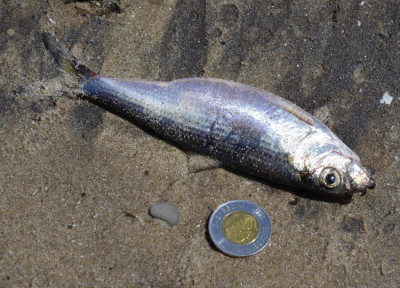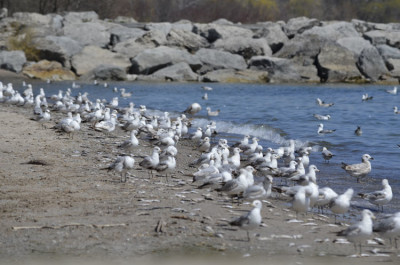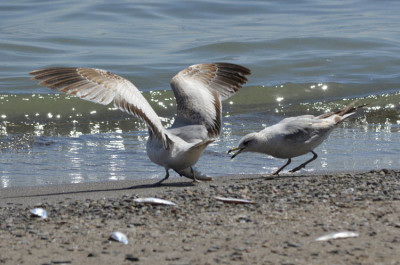With the opening of the St. Lawrence Seaway, new plants and animals including fish have been introduced into the Great Lakes. Some swam their way up through the locks. Others were carried in bilge water and pumped out by ocean-crossing boats. Either way, Lake Ontario, especially, has had to accept many new inhabitants. We often hear about the damage these creatures, from Sea Lampreys to Zebra Mussels, cause to the local ecosystem. But the Great Lakes themselves are not always welcoming to the newcomers either.
How and When Did Alewife Fish Invade Lake Ontario?
One small fish invaded Lake Ontario in the late 1800s long before the Seaway was built. It is called an Alewife. They are actually quite pretty silver fish that have a rainbow of iridescence on their scaly sides. Their faces are not so attractive as they have a large sucker-like mouth. According to the Fishes of Toronto, Alewives are native to the east coast of North America. They likely got into the lakes through the Erie Canal.
According to Fishes of Toronto, Alewives are common in Lake Ontario at the depth where the temperature drops quickly to cold. The book says that trout and salmon eat Alewives.
Alewives apparently displace native small fishes like Perch and Cisco.
Why Do Lots of Alewives Die Suddenly in Lake Ontario?
Lake Ontario also interferes with the Alewives. For some reason, these small fish are not well suited to sudden changes in water temperature or in the amount of oxygen in the water. Either type of change can result in a massive kill of Alewives. In fact, it soon becomes apparent just how many of these fish inhabit the Lake when they start washing up in the thousands and even tens of thousands on the shore.
Before researching this article, I had mistakenly believed that Alewives also die off after they spawn but this is not true.
This spring while rambling through the Rattray Marsh I eventually wound up at the edge of the sandy beaches of Jack Darling Park. As I crested the small grassy hill that overlooks the park, I saw perhaps the largest flock of Ring Billed Gulls I’d ever seen at this spot. There were also flocks of Cormorants winging in and landing.
Looking down I realized why. The Alewives were dying. The gulls were glutting themselves on mostly-fresh fish. Some birds were eating the still flopping fish dying in the shallows along shore. Others were happy to eat a sand-covered Alewife that had expired already.
I found it very amusing to watch the Ring Billed Gulls that did not yet have their adult plumage. These youngsters would actually chase another gull after it picked up a fish, trying to steal it. They were practically tripping on all the other fish, dead and alive, underfoot, but still preferred the one someone else got first!
I’m not sure if the Cormorants ate any of the dead fish. It seems unlikely as they were slightly further off shore. Instead they were likely either eating the dying fish or eating any other fish that were eating the doomed Alewives.
Related Reading
Join In
Have you ever experienced an Alewife event? I can still remember the stench of rotting fish from my youth. Not fun! Please share your experiences with a comment.






There was (is) a die off happening today May 26, at the mouth of the Credit River in Port Credit. Thousands ranging from a few inches up to about 10″. The birds were having a ball!
I heard about this from OntBirds: apparently it attracted some unusual gulls, too, including an adult Laughing Gull on May 24.
Thanks for sharing your experience! It’s quite something to see so many birds in such a small part of the Lake.
I can remember as a kid walking the shore of Lake Ontario near Oshawa and there were thousands of dead or dying fish all over the beach. We were told at the time that they were smelt. I was talking to someone at work who disputed that and that was how I ended up finding this article. Thanks for the education!!
It is true that some years ago, Lake Ontario had a large population of Smelt and there were occasional die offs of those, too. So the ones in your younger years might have been either type of fish, but the more common ones along Lake Ontario nowadays are Alewives.